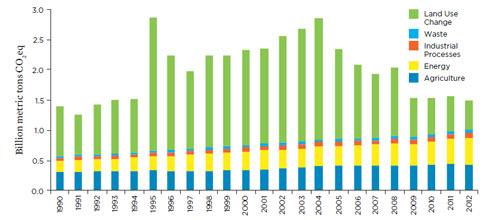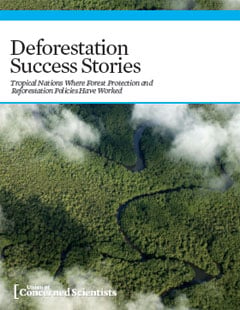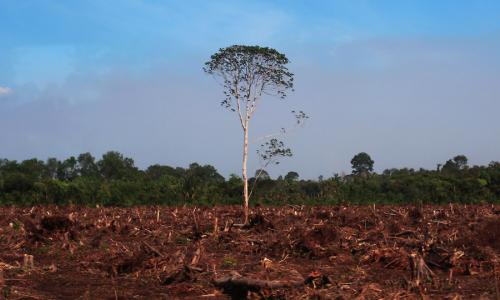In the 1990s, deforestation was consuming 16 million hectares a year—an area about the size of the state of Georgia—and was responsible for about 17 percent of the global warming pollution that threatens the world with dangerous climate change.
But today the pace of deforestation is down. Effective programs and policies—driven by individuals, communities, national governments and the private sector—have contributed to positive impacts for forest conservation, socioeconomic development and forest/land-use changes. Lessons drawn from these success stories could be replicated elsewhere to help reduce deforestation and increase reforestation.
Implementing REDD+
Policies to reduce emissions from deforestation and degradation (REDD+) have been implemented in many countries and across a wide range of scales. Many current REDD+ programs and projects evolved from earlier efforts to reduce deforestation for non-climate reasons, such as biodiversity, wildlife, ecotourism, and poverty alleviation.
But as global concern about climate change has grown in recent years, REDD+ has taken on an explicit climate focus, with an emphasis on reducing emissions and compensation linked to verified reductions. REDD+ financing has proved to be money well spent in Guyana, Brazil, Kenya, Madagascar, and Costa Rica.
Providing payments for ecosystem services (PES)
PES programs, which provide financial compensation for environmental protection, have become well established in countries such as Costa Rica, Mexico, and Vietnam. These programs have been successful in reducing deforestation and promoting reforestation, particularly when used in combination with protected areas, community development efforts, and reorientation of agricultural growth in forest-friendly directions.
Strong governance and enforcement
Strengthening governance and enforcement mechanisms has helped establish effective management, transparency, and the rule of law in central Africa and Brazil in the face of weak governance, corruption, complex political structures, and long-prevalent dominance of rural areas by entrenched elites. Simply enforcing existing laws effectively has paid off in the long term in reduced deforestation and transformed expectations of “how things are done.”

What a deforestation success story looks like: in Brazil, emissions due to deforestation (green) have taken such a sharp downturn since 2004 that overall emissions have decreased in spite of continued increases from other causes. (Source: Data are from the Observatorio do Clima’s Sistema de Estimativa de Emiss ões de Gases de Efeito Estufa [SEEG; System for the Estimation of Greenhouse Gases], analyzed by climate expert Tass o Azevedo [Azevedo 2012].)
Establishing moratoria
Permanent or even temporary halts to the activities that drive deforestation can have important effects. These moratoria need not be on deforestation itself, but rather on the permits or purchases that drive it. Even when they are initially implemented only for a year or two, moratoria can be renewed repeatedly and in effect become part of the landscape’s new reality—as has happened in Brazil with beef and soy.
Combining environmental action with social and economic development
Nearly every story of success involves empowering local communities and decentralizing forest management decisions, using methods such as indigenous reserves and community forestry management systems. Many of these efforts have linked ecosystem services and poverty reduction, resulting in emissions reductions, though not always in economic benefits.
International financing has also been an important element of all the success stories. Funders and governments should continue to pursue efforts to reduce emissions in the land sector—as they clearly can be major players in the global effort to curb global warming.
The path to global success: bending the curve

Each country is at a different point along the curve of forest transition from increasing deforestation to decreasing deforestation to reforestation (right). Effectively combating global warming will require changes along each part of this curve: avoiding the commencement of deforestation (in countries such as Guyana and the central African nations), reducing deforestation in the curve’s steep slope (Brazil, Indonesia, Madagascar, Tanzania, Mozambique, Kenya, and Mexico), and finally moving to net reforestation (Costa Rica, India, El Salvador, and Vietnam).
In effect, the international community has to actively bend the curve rather than assume it will progress by itself. This will turn individual success stories, like those found in this report, into a global success story.





